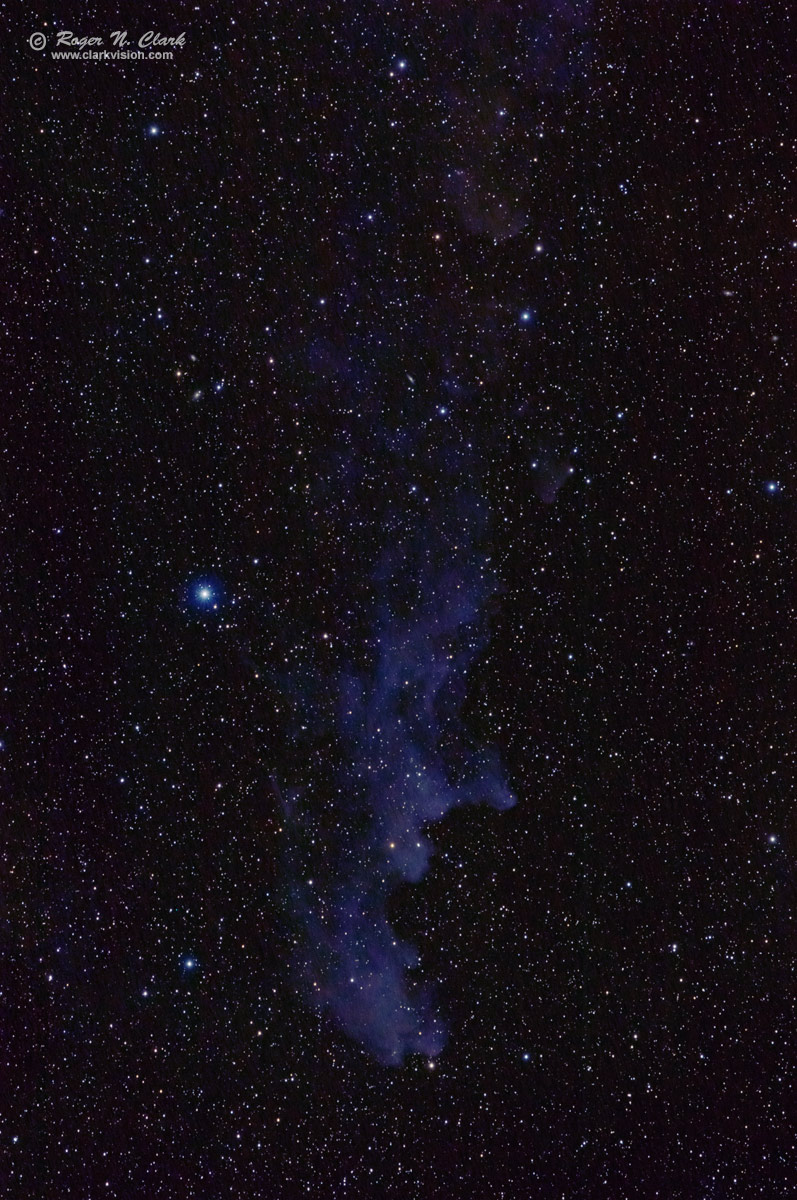| Home | Galleries | Articles | Reviews | Best Gear | New | About | Contact | Gallery Index | Previous |
Next |

| Home | Galleries | Articles | Reviews | Best Gear | New | About | Contact | Gallery Index | Previous |
Next |

The Witch Head nebula, IC2118 is a very faint reflection nebula near the constellation Eridanus and Orion border. The blue color comes from it being illuminated by the blue star Rigel, and the fact that the dust particles in the nebula are much smaller than the wavelength of visible light. Such scattered light is very blue for the same reason our daytime sky is blue. The process is called Rayleigh scattering. South is up in this image to better show the witch head shape.
Technical. Canon 7D Mark II 20-megapixel digital camera and 300 mm f/2.8 L IS II at f/2.8. Thirty-six 60-second exposures at ISO 1600 were added (36 minutes total exposure). No dark frame subtraction, no flat fields, no noise reduction. Tracking with an astrotrac. The image was made in Hawaii on a warm night and trade winds shaking the setup. Out of many images, I was only able to use 36 frames--those without wind shake. The warm environment raised the sensor temperature to 33 degrees Centigrade, so dark current, light pollution, and vog from the erupting volcano on the island all limited how faint I could image. Still, this faint nebula demonstrates that the 7D Mark II is an amazing low light camera for it to record so much detail in this exposure and environment. Full size image is at 2.8 arc-seconds per pixel. Note the small galaxy cluster above and left of the nebula (above the bright star). This is the full image with no crop.
The Exposure Factors, CEF, CEFA are measures of the relative amounts of light received from a subject. It can be used to fairly compare wildly different lens/telescope apertures and exposure times. For this image:
Modern DSLRs like the 7D Mark II include on sensor dark current suppression and low fixed pattern noise at ISOs around 1600 and higher, making no need for dark frame subtraction. Modern raw converters correct for light fall-off and also correct for hot/dead/stuck pixels. This makes processing low light images easy: simply align and average. See my series on Astrophotography Image Processing and Image Sharpening for more details.
The color balance is close to true color, meaning this is a stock camera with very close spectral response similar to the human eye. Astrophotographers often modify cameras for increased sensitivity to Hydrogen-alpha emission (red). Hydrogen emission nebulae actually appear pink due to H-alpha (red), H-beta (blue) and emission from other atoms, like oxygen and sulfur. Modified cameras over emphasize H-alpha, making hydrogen emission nebulae come out red in photos. Unmodified cameras do a better job at color separation of the various processes that occur in the deep sky.
To learn how to obtain stunning images like this, please visit my Extensive Articles on Photography .
See my review of the Canon 7D Mark II and why it is so good for astrophotography: Canon 7D Mark II sensor analysis.
Keywords to this image = astrophoto-1 nebula low-light digital_astro canon_7d2
Image ID: witchhead-nebula.rnclark.300mm.c01.31.2016.0J6A6715-54-av36.e-1200.jpg
| Home | Galleries | Articles | Reviews | Best Gear | Science | New | About | Contact |
Last updated April 02, 2025